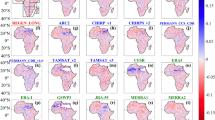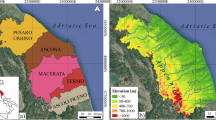Abstract
The accuracy of daily output of satellite and reanalysis data is quite crucial for crop yield prediction. This study has evaluated the performance of APHRODITE (Asian Precipitation-Highly-Resolved Observational Data Integration Towards Evaluation), PERSIANN (Rainfall Estimation from Remotely Sensed Information using Artificial Neural Networks), TRMM (Tropical Rainfall Measuring Mission), and AgMERRA (The Modern-Era Retrospective Analysis for Research and Applications) precipitation products to apply as input data for CSM-CERES-Wheat crop growth simulation model to predict rainfed wheat yield. Daily precipitation output from various sources for 7 years (2000–2007) was obtained and compared with corresponding ground-observed precipitation data for 16 ground stations across the northeast of Iran. Comparisons of ground-observed daily precipitation with corresponding data recorded by different sources of datasets showed a root mean square error (RMSE) of less than 3.5 for all data. AgMERRA and APHRODITE showed the highest correlation (0.68 and 0.87) and index of agreement (d) values (0.79 and 0.89) with ground-observed data. When daily precipitation data were aggregated over periods of 10 days, the RMSE values, r, and d values increased (30, 0.8, and 0.7) for AgMERRA, APHRODITE, PERSIANN, and TRMM precipitation data sources. The simulations of rainfed wheat leaf area index (LAI) and dry matter using various precipitation data, coupled with solar radiation and temperature data from observed ones, illustrated typical LAI and dry matter shape across all stations. The average values of LAImax were 0.78, 0.77, 0.74, 0.70, and 0.69 using PERSIANN, AgMERRA, ground-observed precipitation data, APHRODITE, and TRMM. Rainfed wheat grain yield simulated by using AgMERRA and APHRODITE daily precipitation data was highly correlated (r2 ≥ 70) with those simulated using observed precipitation data. Therefore, gridded data have high potential to be used to supply lack of data and gaps in ground-observed precipitation data.







Similar content being viewed by others
References
Angulo C, Rotter R, Trnka M, Pirttioja N, Gaiser T, Hlavinka P, Ewert F (2013) Characteristic ‘fingerprints’ of crop model responses to weather input data at different spatial resolutions. Eur J Agron 49(0):104–114
Asseng S, Ewert F, Martre P et al (2015) Rising temperatures reduce global wheat production. Nat Clim Chang 5:143–147
Bannayan M, Hoogenboom G (2008) Weather analogue: a tool for real-time prediction of daily weather data realizations based on a modified k-nearest neighbour approach. Environ Model Softw 23(6):703–713
Bannayan M, Lotfabadi SS, Sanjani S, Mohamadian A, Aghaalikhani M (2011) Effects of precipitation and temperature on crop production variability in Northeast Iran. Int J Biometeorol 55:387–401. https://doi.org/10.1007/s00484-010-0348-7
Bannayan M, Mansoori H, Eyshi Rezaei E (2013) Estimating climate change, CO2 and technology development effects on wheat yield in Northeast Iran. Int J Biometeorol 58(3):395–405. https://doi.org/10.1007/s00484-013-0635-1
Berg A, Sultan B, de Noblet-Ducoudré N (2010) What are the dominant features of rainfall leading to realistic large-scale crop yield simulations in West Africa? Geophys Res Lett 37:L05405
Bosilovich MG, Chen J, Robertson FR, Adler RF (2008) Evaluation of global precipitation in reanalysis. J Appl Meteorol Clim 47:2279–2299
Ceglar A, Toreti A, Balsamo G, Kobayashi SH (2017) Precipitation over monsoon Asia: a comparison of reanalyses and observations. J Clim 30:465–476
Chang CL, Lo SL, Yu SL (2005) Applying fuzzy theory and genetic algorithm to interpolate precipitation. J Hydrol 314(1–4):92–104
Daly C, Neilson RP, Phillips DL (1994) A statistical-topographic model for mapping climatological precipitation over mountainous terrain. J Appl Meteorol 33:140–158
De Wit AJW, Boogaard HL, van Diepen CA (2005) Spatial resolution of precipitation and radiation: the effect on regional crop yield forecasts. Agric Forest Meteorol 135:156–168
Edwards K A, Classen G A, Schroten, E H J (1983) The water resource in tropical Africa and its exploitation. ILCA research report no. 6. Available online: http://ww.fao.org/wairdocs/ilri/x5524e/x5524e00.htm#contents
Eyshi Rezaei E, Bannayan M (2012) Rain-fed wheat yields under climate change in northeastern Iran. Meteorol Appl 19(3):346–354
Goovaerts P (1997) Geostatistics for natural resources evaluation, Oxford University Press, New York, Oxford 483
Grimes DIF (2008) An ensemble approach to uncertainty estimation for satellite based rainfall estimates in hydrological modelling and the water cycle: coupling the atmospheric and hydrological models. Water Sci Technol Libr 63:145–162
Hong Y, Hsu K, Gao X, Sorooshian S (2004) Precipitation estimation from remotely sensed imagery using artificial neural network cloud classification system. J Appl Meteorol 43:1834–1853
Hoogenboom G, Jones J W, Wilkens, P W et al (2015) Decision Support System for Agrotechnology Transfer (DSSAT) version 4.6 (www.DSSAT.net). DSSAT Foundation, Prosser, Washington
Hossain F, Anagnostou EN, Bagtzoglou A (2006) On Latin hypercube sampling for efficient uncertainty estimation of satellite rainfall observations in flood prediction. Comput Geosci 32:776–792
Huffman GJ, Adler RF, Bolvin DT et al (2007) The TRMM multi-satellite precipitation analysis: quasi-global, multi-year, combined-sensor precipitation estimates at fine scale. J Hydrometeorol 8:38–55
Jackson IJ (1977) Climate, water and agriculture in the tropics. Longman, New York
Johansson B, Chen D (2003) The influence of wind and topography on precipitation distribution in Sweden: statistical analysis and modelling. Int J Climatol 23:1523–1535. https://doi.org/10.1002/joc.951
Jones JW, Hoogenboom G, Porter CH et al (2003) DSSAT cropping system model. Eur J Agron 18:235–265
Kamiguchi K, Arakawa O, Kitoh A et al (2010) Development of APHRO_JP, the first Japanese high-resolution daily precipitation product for more than 100 years. HRL 4:60–64
Kersebaum KC, Boote KJ, Jorgenson JSC et al (2015) Analysis and classification of data sets for calibration and validation of agro-ecosystem models. Environ Model Softw 72:402–417
Koocheki A, Azemzade M (1999) Effects of different levels of phosphorus and planting densities on wheat in Khorasan province conditions. J Agric Sci Ind 13:131–139 (abstract in English)
Lashkari A, Alizadeh A, Eyshi Rezaei E, Bannayan M (2012) Mitigation of climate change impacts on maize productivity in northeast of Iran: a simulation study. Mitig Adapt Strategies Glob Chang 17(1):1–16
Lauri H, Räsänen TA, Kummu M (2014) Using reanalysis and remotely sensed temperature and precipitation data for hydrological modelling in monsoon climate: Mekong River case study. J Hydrometeorol 15:1532–1545
Legates DR, McCabe GJ Jr (1999) Evaluating the use of goodness-of-fit measures in hydrologic and hydroclimatic model validation. Water Resour Res 35(1):233–241
Lobell DB, Field CB (2007) Global scale climate-crop yield relationships and the impacts of recent warming. Environ Res Lett 2:014002
Nalder IA, Wein RW (1998) Spatial interpolation of climatic normal: test of a new method in the Canadian boreal forest. Agric For Meteorol 92:211–225
National Centre for Atmospheric Research Staff (Eds). Last modified 05 Nov 2014. The climate data guide: precipitation data sets: overview & comparison table. Retrieved from https://climatedataguide.ucar.edu/climate-data/precipitation-data-sets-overview- comparison-table
NetCDF-Extractor (2017) AgriMetSoft, Download from https://www.agrimetsoft.com
Nouri M, Homaee M, Bannayan M (2017) Climate variability impacts on rainfed cereal yields in west and Northwest Iran. Int J Biometeorol 69(9): 1571–1583. do:https://doi.org/10.1007/s00484-017-1336-y
Oettli P, Sultan B, Baron C, Vrac M (2011) Are regional climate models relevant for crop yield prediction in West Africa? Environ Res Lett 6:014008
Parry ML, Rosenzweig C, Iglesias A et al (2004) Effects of climate change on global food production under SRES emissions and socio-economic scenarios. Glob Environ Change 14(1):53–67
Porter JR, Semenov MA (2005) Crop responses to climatic variation. Phil Trans R Soc B 360:2021–2035
Ramarohetra J, Sultan B, Baron C (2013) How satellite rainfall estimate errors may impact rain-fed cereal yield simulation in West Africa. Agric For Meteorol 180:118–131
Rienecker MM, Suarez MJ, Gelaro R (2011) MERRA: NASA’s modern-era retrospective analysis for research and applications. J Clim 24:3624–3648
Roca R, Chambon P, Jobard I (2010) Comparing satellite and surface rainfall products over West Africa at meteorological relevant scales during the AMMA campaign using error estimates. J Appl Meteorol Clim 49:715–731
Ruane A, Goldberg R, Chryssanthacopoulos J (2015) Climate forcing datasets for agricultural modelling: merged products for gap-filling and historical climate series estimation. Agric For Meteorol 200:233–248
Sharifi HR, Rahimian Mashhadi H (2001) Effects of drought stress, density, and cultivar on rain-fed wheat in Khorasan province situations. Agric Sci Nat Resour 8:115–130 (abstract in English)
Tubiello FN, Donatelli M, Rosenzweig C, Stockle CO (2000) Effects of climate change and elevated CO2 on cropping systems: model predictions at two Italian locations. Eur J Agron 13(2–3):179–189
Ullah A, Ahmad A, Khaliq T, Akhtar J (2017) Recognizing production options for pearl millet in Pakistan under changing climate scenarios. J Integr Agric 16(4):762–773. https://www.sciencedirect.com/science/article/pii/S2095311916614508
van Ittersum MK, Ewert F, Heckelei T (2008) Integrated assessment of agricultural systems—a component-based framework for the European Union (SEAMLESS). Agric Syst 96(1–3):150–165
Valéry A, Andréassian V, Perrin C (2010) Regionalization of precipitation and air temperature over high-altitude catchments learning from outliers. Hydrol Sci J 55(6):928–940. https://doi.org/10.1080/02626667.2010.504676
Vicente GA, Scofield RA, Menzel WP (1998) The operational GOES infrared rainfall estimation technique. Bull Am Meteorol Soc 79:1883–1898
Wallach D, Makowski D, Jones JW (2006) Working with dynamic crop models: evaluations, analysis, parameterization and applications, First edn. Science, Elsevier
Wallach D, Thorburn P, Asseng S (2016) Estimating model prediction error: should you treat predictions as fixed or random? Environ Model Softw 84:529–539
White JW, Hoogenboom G, Stackhouse PW Jr, Hoell JM (2008) Evaluation of NASA satellite- and assimilation model-derived long-term daily temperature data over the continental US. Agric For Meteorol 148:1574–1584
Willmott CJ (1981) On the validation of models. Phys Geogr 2(2):184–194
Wu J, Liu M, Lü A, He B (2014) The variation of the water deficit during the winter wheat growing season and its impact on crop yield in the North China Plain. Int J Biometeorol 58:1951–1960. https://doi.org/10.1007/s00484-014-0798-4
Yatagai A, Arakawa O, Kamiguchi K (2009) A 44-year daily gridded precipitation dataset for Asia based on a dense network of rain gauges. SOLA 5:137–140
Yatagai A, Kamiguchi K, Arakawa O (2012) APHRODITE: constructing a long-term daily gridded precipitation dataset for Asia based on a dense network of rain gauges. Bull Am Meteorol Soc 93:1401–1415
Yan J, Gebremichael M (2009) Estimating actual rainfall from satellite rainfall products. Atmos Res 92:481–488
Yang Y, Wang G, Wang L (2014) Evaluation of gridded precipitation data for driving SWAT model in area upstream of three gorges reservoir. PLoS One 9(11):e112725
Author information
Authors and Affiliations
Corresponding author
Rights and permissions
About this article
Cite this article
Lashkari, A., Salehnia, N., Asadi, S. et al. Evaluation of different gridded rainfall datasets for rainfed wheat yield prediction in an arid environment. Int J Biometeorol 62, 1543–1556 (2018). https://doi.org/10.1007/s00484-018-1555-x
Received:
Revised:
Accepted:
Published:
Issue Date:
DOI: https://doi.org/10.1007/s00484-018-1555-x




